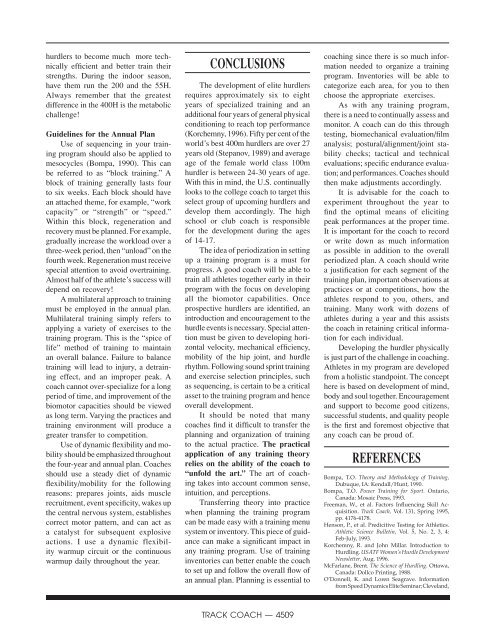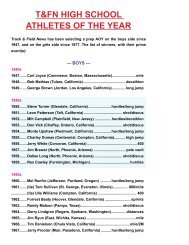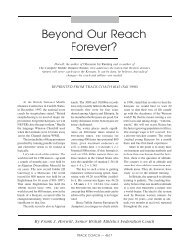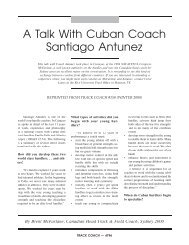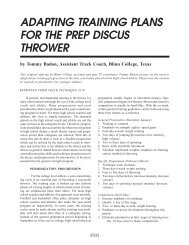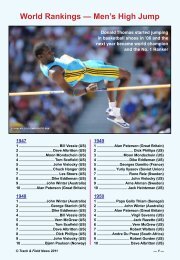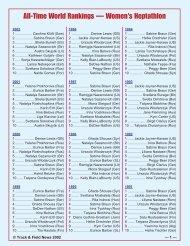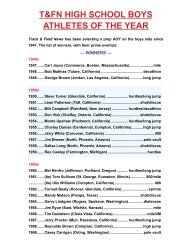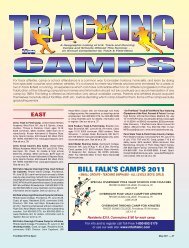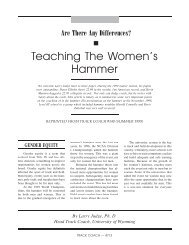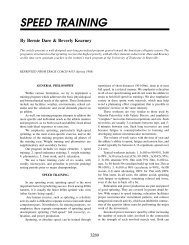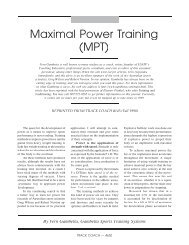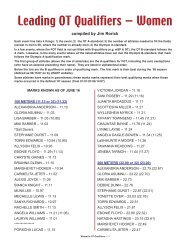Identifying And Developing Elite Hurdlers In The United States
Identifying And Developing Elite Hurdlers In The United States
Identifying And Developing Elite Hurdlers In The United States
Create successful ePaper yourself
Turn your PDF publications into a flip-book with our unique Google optimized e-Paper software.
hurdlers to become much more technically<br />
efficient and better train their<br />
strengths. During the indoor season,<br />
have them run the 200 and the 55H.<br />
Always remember that the greatest<br />
difference in the 400H is the metabolic<br />
challenge!<br />
Guidelines for the Annual Plan<br />
Use of sequencing in your training<br />
program should also be applied to<br />
mesocycles (Bompa, 1990). This can<br />
be referred to as “block training.” A<br />
block of training generally lasts four<br />
to six weeks. Each block should have<br />
an attached theme, for example, “work<br />
capacity” or “strength” or “speed.”<br />
Within this block, regeneration and<br />
recovery must be planned. For example,<br />
gradually increase the workload over a<br />
three-week period, then “unload” on the<br />
fourth week. Regeneration must receive<br />
special attention to avoid overtraining.<br />
Almost half of the athlete’s success will<br />
depend on recovery!<br />
A multilateral approach to training<br />
must be employed in the annual plan.<br />
Multilateral training simply refers to<br />
applying a variety of exercises to the<br />
training program. This is the “spice of<br />
life” method of training to maintain<br />
an overall balance. Failure to balance<br />
training will lead to injury, a detraining<br />
effect, and an improper peak. A<br />
coach cannot over-specialize for a long<br />
period of time, and improvement of the<br />
biomotor capacities should be viewed<br />
as long term. Varying the practices and<br />
training environment will produce a<br />
greater transfer to competition.<br />
Use of dynamic flexibility and mobility<br />
should be emphasized throughout<br />
the four-year and annual plan. Coaches<br />
should use a steady diet of dynamic<br />
flexibility/mobility for the following<br />
reasons: prepares joints, aids muscle<br />
recruitment, event specificity, wakes up<br />
the central nervous system, establishes<br />
correct motor pattern, and can act as<br />
a catalyst for subsequent explosive<br />
actions. I use a dynamic flexibility<br />
warmup circuit or the continuous<br />
warmup daily throughout the year.<br />
CONCLUSIONS<br />
<strong>The</strong> development of elite hurdlers<br />
requires approximately six to eight<br />
years of specialized training and an<br />
additional four years of general physical<br />
conditioning to reach top performance<br />
(Korchemny, 1996). Fifty per cent of the<br />
world’s best 400m hurdlers are over 27<br />
years old (Stepanov, 1989) and average<br />
age of the female world class 100m<br />
hurdler is between 24-30 years of age.<br />
With this in mind, the U.S. continually<br />
looks to the college coach to target this<br />
select group of upcoming hurdlers and<br />
develop them accordingly. <strong>The</strong> high<br />
school or club coach is responsible<br />
for the development during the ages<br />
of 14-17.<br />
<strong>The</strong> idea of periodization in setting<br />
up a training program is a must for<br />
progress. A good coach will be able to<br />
train all athletes together early in their<br />
program with the focus on developing<br />
all the biomotor capabilities. Once<br />
prospective hurdlers are identified, an<br />
introduction and encouragement to the<br />
hurdle events is necessary. Special attention<br />
must be given to developing horizontal<br />
velocity, mechanical efficiency,<br />
mobility of the hip joint, and hurdle<br />
rhythm. Following sound sprint training<br />
and exercise selection principles, such<br />
as sequencing, is certain to be a critical<br />
asset to the training program and hence<br />
overall development.<br />
It should be noted that many<br />
coaches find it difficult to transfer the<br />
planning and organization of training<br />
to the actual practice. <strong>The</strong> practical<br />
application of any training theory<br />
relies on the ability of the coach to<br />
“unfold the art.” <strong>The</strong> art of coaching<br />
takes into account common sense,<br />
intuition, and perceptions.<br />
Transferring theory into practice<br />
when planning the training program<br />
can be made easy with a training menu<br />
system or inventory. This piece of guidance<br />
can make a significant impact in<br />
any training program. Use of training<br />
inventories can better enable the coach<br />
to set up and follow the overall flow of<br />
an annual plan. Planning is essential to<br />
coaching since there is so much information<br />
needed to organize a training<br />
program. <strong>In</strong>ventories will be able to<br />
categorize each area, for you to then<br />
choose the appropriate exercises.<br />
As with any training program,<br />
there is a need to continually assess and<br />
monitor. A coach can do this through<br />
testing, biomechanical evaluation/film<br />
analysis; postural/alignment/joint stability<br />
checks; tactical and technical<br />
evaluations; specific endurance evaluation;<br />
and performances. Coaches should<br />
then make adjustments accordingly.<br />
It is advisable for the coach to<br />
experiment throughout the year to<br />
find the optimal means of eliciting<br />
peak performances at the proper time.<br />
It is important for the coach to record<br />
or write down as much information<br />
as possible in addition to the overall<br />
periodized plan. A coach should write<br />
a justification for each segment of the<br />
training plan, important observations at<br />
practices or at competitions, how the<br />
athletes respond to you, others, and<br />
training. Many work with dozens of<br />
athletes during a year and this assists<br />
the coach in retaining critical information<br />
for each individual.<br />
<strong>Developing</strong> the hurdler physically<br />
is just part of the challenge in coaching.<br />
Athletes in my program are developed<br />
from a holistic standpoint. <strong>The</strong> concept<br />
here is based on development of mind,<br />
body and soul together. Encouragement<br />
and support to become good citizens,<br />
successful students, and quality people<br />
is the first and foremost objective that<br />
any coach can be proud of.<br />
REFERENCES<br />
Bompa, T.O. <strong>The</strong>ory and Methodology of Training,<br />
Dubuque, IA: Kendall/Hunt, 1990.<br />
Bompa, T.O. Power Training for Sport. Ontario,<br />
Canada: Mosaic Press, 1993.<br />
Freeman, W., et al. Factors <strong>In</strong>fluencing Skill Acquisition.<br />
Track Coach, Vol. 131, Spring 1995,<br />
pp. 4176-4178.<br />
Henson, P., et al. Predicitive Testing for Athletics.<br />
Athletic Science Bulletin, Vol. 5, No. 2, 3, 4:<br />
Feb-July, 1993.<br />
Korchemny, R. and John Millar. <strong>In</strong>troduction to<br />
Hurdling. USATF Women’s Hurdle Development<br />
Newsletter, Aug. 1996.<br />
McFarlane, Brent. <strong>The</strong> Science of Hurdling. Ottawa,<br />
Canada: Dollco Printing, 1988.<br />
O’Donnell, K. and Loren Seagrave. <strong>In</strong>formation<br />
from Speed Dynamics <strong>Elite</strong> Seminar; Cleveland,<br />
TRACK COACH — 4509


